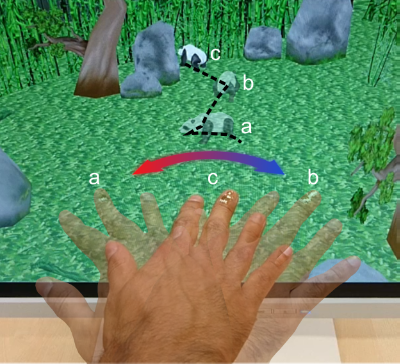December 23, 2018 – At the Helmholtz-Zentrum Dresden-Rossendorf (HZDR) Research Centre in Germany, scientists and engineers have developed E-skin with magnetosensitive properties that can orient a wearer to the Earth’s magnetic field. It is a bionic equivalent to the compass.
E-skin, short for electronic skin, is a thin polymer foil (no more than a millimeter thick) that a wearer can use to detect where are north and south. Wearing it a person walking can orient themselves by receiving a digital reading showing in what direction they are heading. The material used by the HZDR researchers is called permalloy consists of thin strips of ferromagnetic material combined with conductive gold slabs, the latter arranged at a 45-degree angle to the former, to create a sensor that can be worn on an index finger.
As electric current passes through the E-skin sensor the flow angle is determined by the conductive gold which causes the voltage read to be strongest pointing to the north, and weakest pointing to the south. The researchers have tested the E-skin sensor both in virtual reality and in the real outdoors. States Cañón Bermúdez, one of the HZDR research team, in a recent press release, “we were able to develop the first soft and ultrathin portable sensor which can reproduce the functionality of a conventional compass and prospective grant artificial magnetoception to humans.”
Magnetoception, also known as magnetoreception, is commonly observed in a number of animal species, particularly birds, sea turtles, lobsters, and insects. So how do these creatures do it?
Avian magnetoreception, according to the latest research, appears to be chemically based. Something called a radical-pair mechanism causing organic chemicals to sense the Earth’s magnetic properties occurs when electrons contained within two atoms spin in opposite directions. As the electron pairs spin they experience magnetic moments that the bird’s brain interprets automatically to align with the magnetic field of the planet.
The mechanism by which sea turtles find their way to the same beach annually in a transoceanic migration that can span thousands of kilometers appears to be based on more complex chemistry or other capacities not exhibited by birds. Sea turtles can pick up not just north and south directions, but Earth’s longitudinal magnetic signatures as well to allow them to precisely navigate both east and west. This means they combine two features of Earth’s magnetic field to create their internal compass or use some other mechanism for longitudinal directions. Could the sea turtle mechanism also use radical pairs of atoms with electrons spinning not spinning in two opposite directions but in four with two at an acute angle to the ones that determine north and south? Or are the turtles sensing unique chemical signatures in the ocean environment that guide them on their migratory path. Studies with loggerhead sea turtles done in controlled environments simulating Earth’s magnetic field indicate that the radical-pair mechanism may be at play here as well. And maybe we have yet to discover similar longitudinal navigation capacity in avian biochemistry.
In reading about avian and sea turtle navigation I wondered if the Monarch Butterfly uses the properties of radical-pair mechanisms as well in its annual migration? It appears not based on current research. Monarchs use light and the position of the Sun to be their navigational compass. That and the geography over which they fly (they don’t like going over tall mountains) confines them to their annual migratory path.
Getting back to E-skin, humans, now outfitted with these sensor-loaded skin patches will be joining the elite club of creatures capable of using Earth’s magnetic field to navigate rather than carrying a compass and maps wherever they go. As I write this I can’t help thinking how useful E-skin would have been to me when I was teaching orienteering taking day trippers out on Ontario’s Bruce Trail. With E-skin we could have dispensed with compasses and folded topographic maps. I would lay bets that the military of a number of countries will come calling at the HZDR Research Centre in the very near future.
















